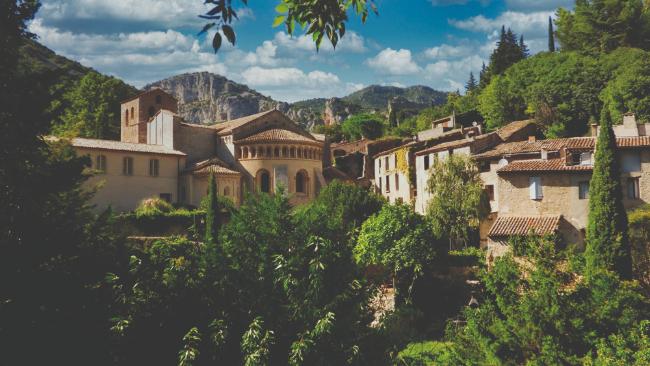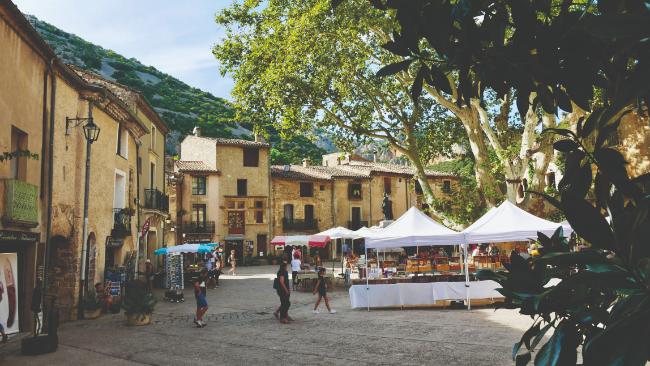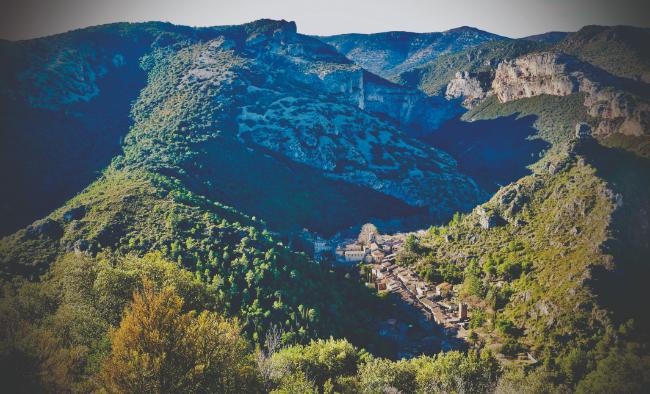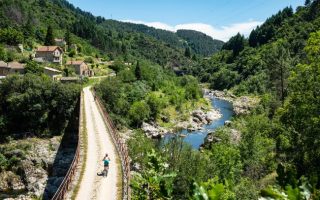The Gorgeous Gorges de l’Hérault in the South of France

This Grand Site offers a wealth of attractions, including stunning Saint-Guilhem-le-Désert and it’s just as enjoyable to visit off-season.
As our group gathers in the depths of the Grotte des Demoiselles and the last lantern goes out, we are plunged into darkness. Next, there’s a tantalising pause as our guide searches for the switch. Then, to gasps of wonder, she lights up the cave to reveal a cavernous chamber as big as a cathedral. It’s a truly spectacular sight and it underlines what a wonderful destination we’ve been lucky enough to visit.
Every Grand Site de France has its own special character, but for all-round appeal, few can match the attractions of the Gorges de l’Hérault. By far the most popular of these (we’ll come back to the Grotte des Demoiselles in a moment) is the medieval village of Saint-Guilhem-le-Désert, so we’ve decided to begin our tour here.

The magical handpan concert at the Grotte de Clamouse, © Steve Turnbull
We’ve also chosen to come off-season in mid-October to avoid the crowds and benefit, slow tourism style, from a more relaxed ambience. As it turns out, we’ve been fortunate with the weather too: it’s pleasantly warm, and the charming square (Place de la Liberté) at the centre of the village is bathed in autumnal sunshine as we meet up with our English-speaking guide from the local tourist office, Amandine Amerdeil. As she explains, the name Saint-Guilhem-le-Désert originates with a very interesting character from the Middle Ages. The second Count of Toulouse and Duke of Aquitaine, William (Guilhem/ Guillaume) of Orange, distinguished himself as a knight on the battlefield. However, he became weary of fighting the Saracens in Spain and increasingly felt a religious calling. This led him to the spiritual ‘desert’ of the Val de Gellone where he swapped his armour for a monk’s habit and founded a Benedictine abbey (Abbaye de Gellone) in 804.
Inside the abbey’s church overlooking the square, we discover two fascinating relics. Allegedly, one contains the bones of William, who died in 814, and the other a piece of Christ’s cross gifted to him by his cousin, Charlemagne. Whatever the truth, they certainly drew increasing numbers of pilgrims to the village and helped to foster a cult around William, consolidated by numerous legends and his canonisation in 1066. Continuing our tour in the cloister and museum, we learn from Amandine that the Romanesque abbey was extended and rebuilt many times over the course of history following floods, long periods of neglect, and the ravages of the French Revolution. Nevertheless, its importance as a landmark on the Chemin de Saint-Jacques continued to grow, culminating with its classification in 1998 as a UNESCO World Heritage Site.

The Abbaye de Gellone at St Guilhem le Désert © Steve Turnbull
A most beautiful village
Exploring the cobbled streets beyond the abbey, we have no difficulty appreciating why Saint-Guilhem-le-Désert itself has been listed as one of France’s Plus Beaux Villages. There are enticing eateries and artisanal boutiques aplenty to cater for visitors, but overall the character is attractively authentic as well as richly historical. In fact, the Musée du Village d’Antan, on the Rue Chapelle des Pénitents, manages to combine all these elements. Here, we meet 70-something Jacques Prouget and his wife, Hélène, whose museum, housed in a 12th- century building, is an Aladdin’s Cave of curios and domestic objects which the couple have collected down the years. A panorama of santons (traditional figurines) has pride of place and rightly so it took master santonnier Jacques more than 11,000 hours to create.

Place de la Liberté at St Guilhem le Désert © Steve Turnbull
Historic hikes
In the afternoon, we’re blessed with more nice weather so we lace up our walking boots and set off for the Cirque de l’Infernet at the far end of the village. A spectacular gorge with towering limestone cliffs, this is also known as bout du monde (world’s end), but the well-marked paths with ubiquitous scallop shell signs on the Chemin de Saint-Jacques (Via Tolosona) route make it easy to navigate. The highlight for us on the classic Circuit des Fenestrettes 10km hike is undoubtedly a walkway built in the 18th century for load- carrying mules it clings precipitously to the rock face (think – Lord of the Rings) and offers fabulous views.
The next day we meet up with Amandine again for a tour of the Pont du Diable (Devil’s Bridge), an 11th-century bridge just along the River Hérault from Saint-Guilhem-le-Désert at the mouth of the gorge. Like the Abbaye de Gellone, this is listed as a UNESCO World Heritage Site due to its significance on the Chemin de Saint-Jacques.
It’s also a stunningly picturesque spot that’s very popular with locals and tourists alike in the summer, not least because the natural lake formed by the widening of the river is ideal for swimming and boating (there are several canoeing stretches along the Hérault). But on our visit it’s blissfully tranquil and we practically have the place to ourselves. As we discover, there are several beautifully-illustrated information plaques dotted around the site. One explains how the bridge was built by monks from the abbeys of Gellone and nearby Aniane under Saint-Benoît; another how the heroic William thwarted the Devil’s attempt to sabotage the construction.

St Guilhem le Désert and the Cirque de l’Infernet, © Steve Turnbull
Later we sample some very impressive organic wines at the nearby Maison du Grand Site and browse the well-stocked gift shop. Following this, we take a short stroll up the hill beyond the bridge to the Maison de la Poterie/Argileum (argile is French for clay) in the delightful village of Saint-Jean-de-Fos. This small-scale but brilliantly designed museum takes us on an interactive journey through the development of the pottery/ceramic industry locally (promoted by the Pont du Diable), as well as the techniques involved.
Our final attraction of the day is conveniently located just beyond the Pont du Diable heading back to Saint-Guilhem-le- Désert. Discovered as recently as 1945 by speleologists from Montpellier, the Grotte de Clamouse is a vast cave which boasts an extraordinary range of concretions, including rare aragonite crystals. Following an introductory video which explains (with English subtitles) how the cave and gorge were created by a process of erosion over millions of years, we press on through a labyrinth of passageways. More adventurous types can explore these further via escape games and other activities, but we’re happy to take a more leisurely approach and enjoy a magically atmospheric handpan concert.
The next morning we say goodbye to Saint-Guilhem-le- Désert and drive deeper down the gorge. The route meanders beside the river for a while then climbs to a garrigue-covered plateau (causse) with the magnificent Massif de la Séranne as a backdrop. After a brief stop to enjoy the gorgeous scenery at the Pont de Saint-Étienne-d’Issensac and another at the pretty village of Brissac for a tasty vegetarian lunch, we head to the Grotte des Demoiselles at the northern perimeter of the Grand Site. The name of the cave derives from a dubious-sounding legend involving a young shepherd, but the person who is credited with exploring it for the first time at the end of 19th century was real enough the illustrious Edouard-Alfred Martel. However, he had to grope around with just the aid of a lantern so, in pursuit of a more authentic experience, the first part of our guided tour takes a similar approach. After the jaw-dropping ‘cathedral’ chamber, we continue in the fully-lit cave and arrive at the ‘statue’ of the Vierge à l’Enfant (Virgin and Child), a beautiful calcite stalagmite that couldn’t be more aptly named.
Sipping a coffee on the lovely restaurant terrace afterwards as we soak up more sunshine (this being the south of France) we reflect on how wonderfully varied our trip has been. We also conclude that the Gorges de l’Hérault is the kind of place you can enjoy whatever the weather and season.
From France Today Magazine

Tasty vegetarian lunch at L’Arboussède restaurant in Brissac, © Steve Turnbull
GORGES DE L’HÉRAULT ESSENTIALS
GETTING THERE
BY PLANE
Fly to Montpellier (about 25 miles from Saint-Guilhem-le- Désert) via all major airports in the UK and budget airlines. There are also fairly regular Ryanair flights to Béziers about an hour’s drive away.
BY TRAIN
There are 6 direct trains from Paris to Montpellier Saint-Roch per day, journey time approx 3 hours. The other option is Montpellier Sud de France on the outskirts of the city.
BY CAR
Around 7 hours from Paris to Saint-Guilhem-le-Désert.
WHERE TO STAY
Le Guilhaume d’Orange Comfortable, characterful hotel with friendly service, ideally located at the foot of Saint- Guilhem-le-Désert on the banks of the river, doubles from €80 per night. Its La Table D’Aurore restaurant serves traditional French food and has a very nice terrace.
WHERE TO EAT
Traditional Mediterranean restaurant at Saint-Jean-de-Fos (vegetarians catered for) with seasonal/local emphasis and a large selection of wines.
Delicious salads and pastries served on a lovely shaded terrace. Museum entry €4.
Traditional, homestyle restau- rant, nicely located in the pretty village square at Brissac.
TOURIST OFFICE
www.saintguilhem-vallee- herault.fr/en
From France Today Magazine
Sorry, it looks like you don’t have access to this content.
Ohlala! It looks like you’re not a Member yet
Join to view this content!
(If you are a Member, log in or reset your password below or contact us so we can help)
- Log in
- Forgot password
Lead photo credit : Hiking the 'bout du monde', Cirque de l'Infernet © Steve Turnbull
Share to: Facebook Twitter LinkedIn Email
More in Grand Sites de France, natural sites, nature in france, South of France, travel stories
Leave a reply
Your email address will not be published. Required fields are marked *



